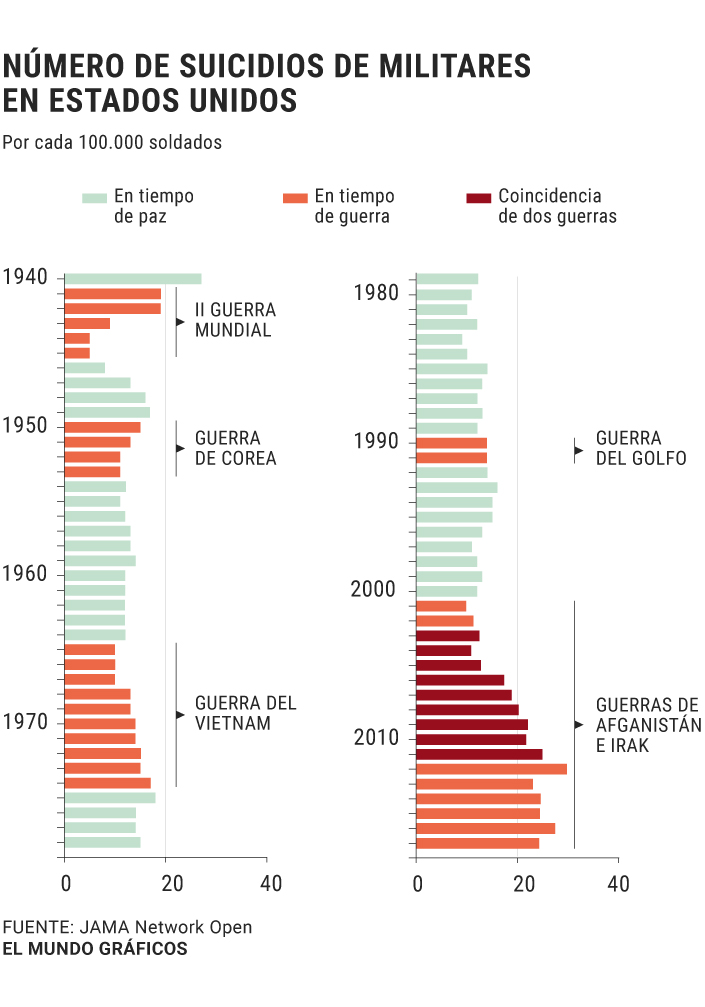- Aftermath: Daniel's suicide upon returning from the war
More than 45,000 members of the United States Army have taken their own lives in the last six years. That means that every year more military personnel die than they fall in combat in Iraq or Afghanistan. In addition, the statistics accumulated in the last decade reflect a worrying upward trend, both among active and veteran soldiers. Part of the effort that the authorities have begun to tackle the problem involves understanding its nature. That is why recently researchers from the University of Hawaii - in collaboration with the Department of Defense - have published an investigation that reviews almost 200 years of data on suicides in the US military.
The analysis, which appears in the medical journal JAMA Network Open , reveals that this increase is a recent phenomenon, especially in time of war. In the period 1840-1940 suicides among active troops always decreased during periods of conflict (Civil War, War of Cuba and World War I) and the rate fell to its lowest level at the end of World War II, 5 deaths per 100,000 service members. However, the trend began to change in Vietnam and has worsened significantly since 2004, with a strong rebound "that exceeds the pre-World War II rates and current rates among the civilian population," according to the study. In 2017, the figure reached 24.3 deaths per 1,000 soldiers.
"The data suggests that war periods have had a suppression effect on suicide rates, rather than increasing them," explains Jeffrey Smith, associate professor in the Department of History at the University of Hawaii and lead author of the study. "That negative trend that associates combat with the increase in suicides in our army is recent." The fact that this change in trend appears in two of the longest wars in the history of the United States points to the duration of conflicts as a possible factor , although according to this researcher "that association should be a subject of future research. ".
On the other hand, the authors acknowledge that the age of some statistics may make them somewhat inaccurate. The oldest data comes from reports by the US Surgeon General, although researchers have chosen to include only deaths directly classified as suicide ; which implies excluding related causes, described in medical journals with terms such as "broken spirit." "It is easy to imagine that there is an underrepresentation of the problem, but that does not prevent a useful analysis," says David Jones, Professor of History of Science at Harvard University and author of a comment that accompanies the article. "A model that explains past trends can help prevent future deaths," Jones adds, "and reveal short-term and long-term stress factors associated with suicide."
Young men, the most affected
The report is part of an effort undertaken by the Department of Defense to tackle the worrying increase in suicide figures among members of the army, which includes an investment of 1,000 million dollars in the search for solutions. However, the authorities are aware that similar studies - such as one conducted in Israel - suggest that the problem is not exclusive to the US military. In fact, it is not even an exclusive problem of the army.
In this sense, the Pentagon pointed out in a report published last September that, once the age and gender have been adjusted, the rate among soldiers is, more or less, the same as that of the rest of society . All studies agree that the population at greatest risk is young men (the main demographic segment in armies) who mostly choose a weapon as a method to end their lives. But beyond the stress related to deployments and combat, "the Army is not isolated from social, cultural and economic changes," the report explained.
"The figures we have are not going in the right direction," said Elizabeth Van Winkle, director of the Office of Resilience in the US Armed Forces. "In general the rates among our military are comparable to that of civilians, but that is no comfort." Experts remember that any study related to suicide is complex, since it is a decision that results from many personal and environmental factors. However, Pentagon officials have drawn some conclusions. For example, that the majority of service members who take their lives do not suffer from previous mental illness . In addition, studies do show that improving medical care and limiting access to lethal means (such as better storage and control of armories) makes a positive difference.
According to the criteria of The Trust Project
Know more- Science and Health
- Graphics
Climate Crisis - Greta Thunberg joins dozens of young people in Madrid for inaction against the climate emergency
EnvironmentStrong rise of Spain in the ranking of the countries most affected by climate change
Climate crisis Zero emissions: a commitment in the air

